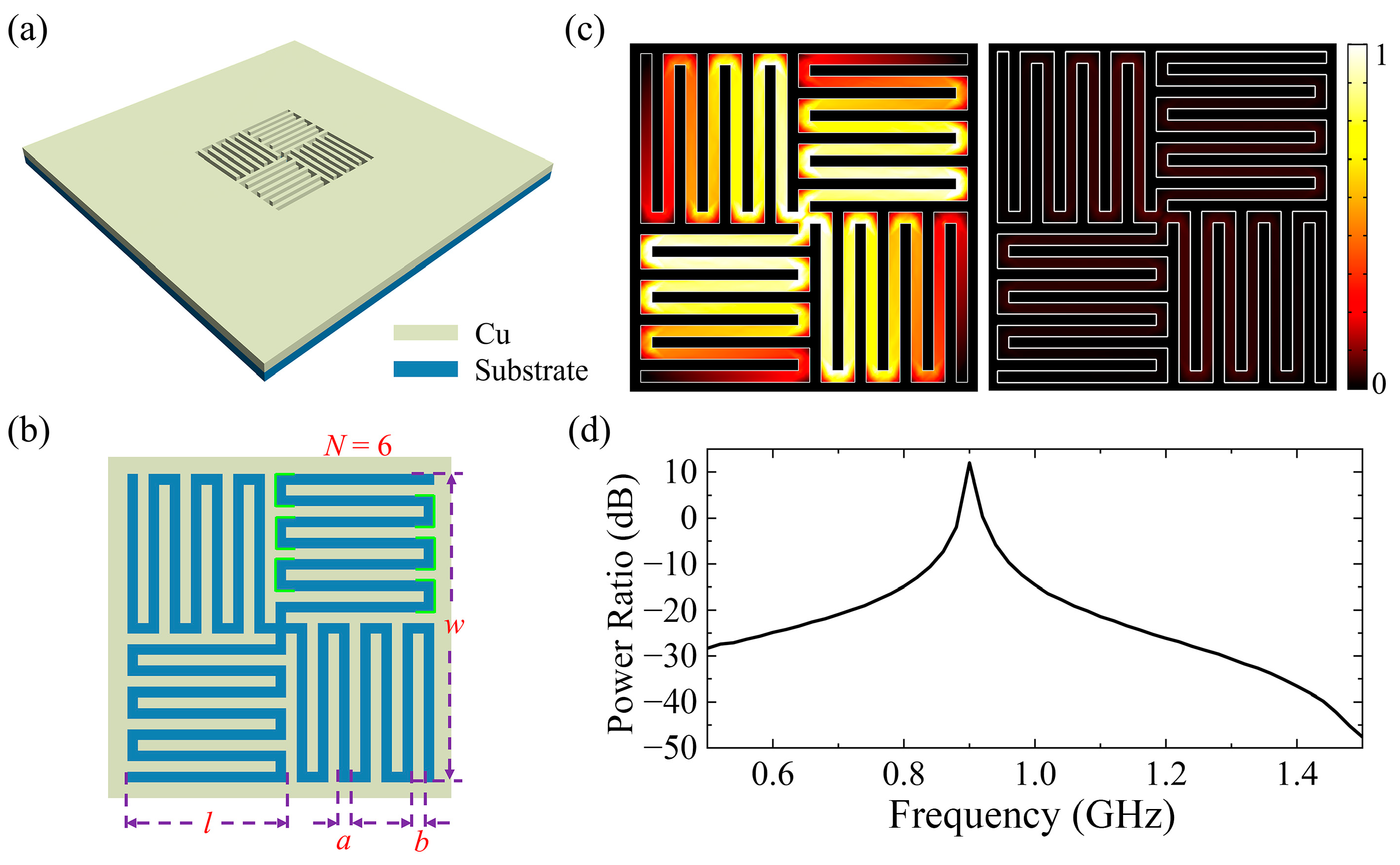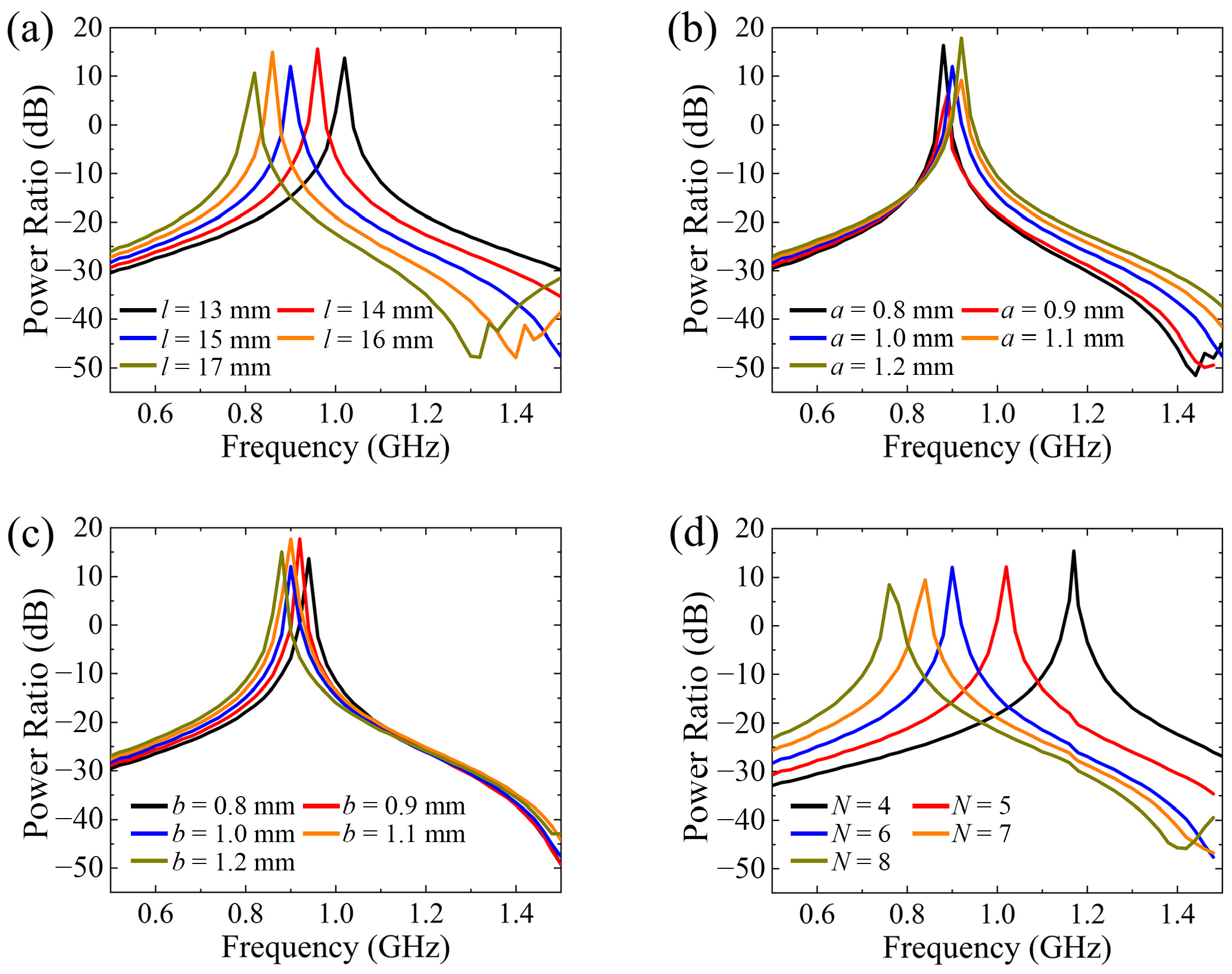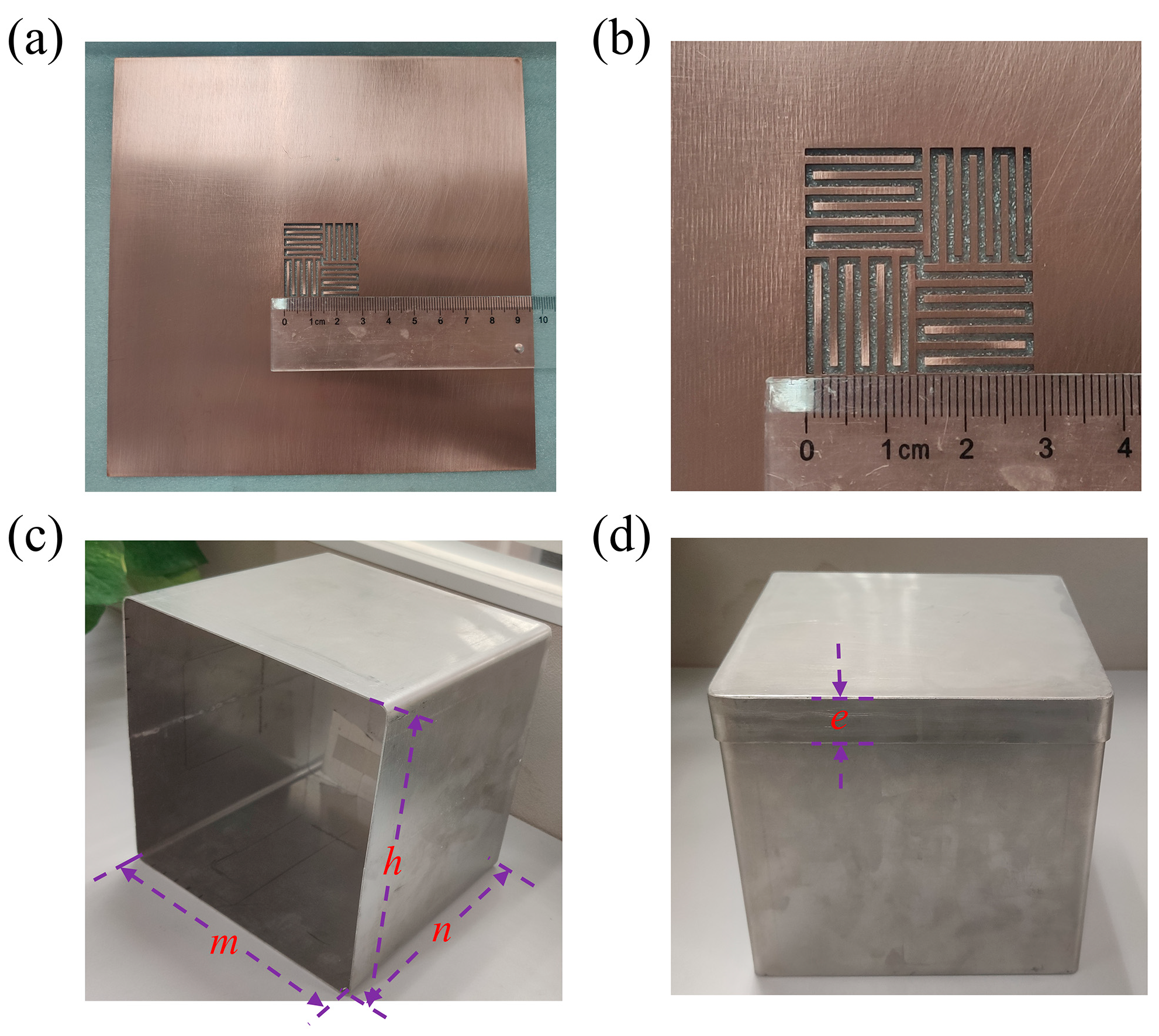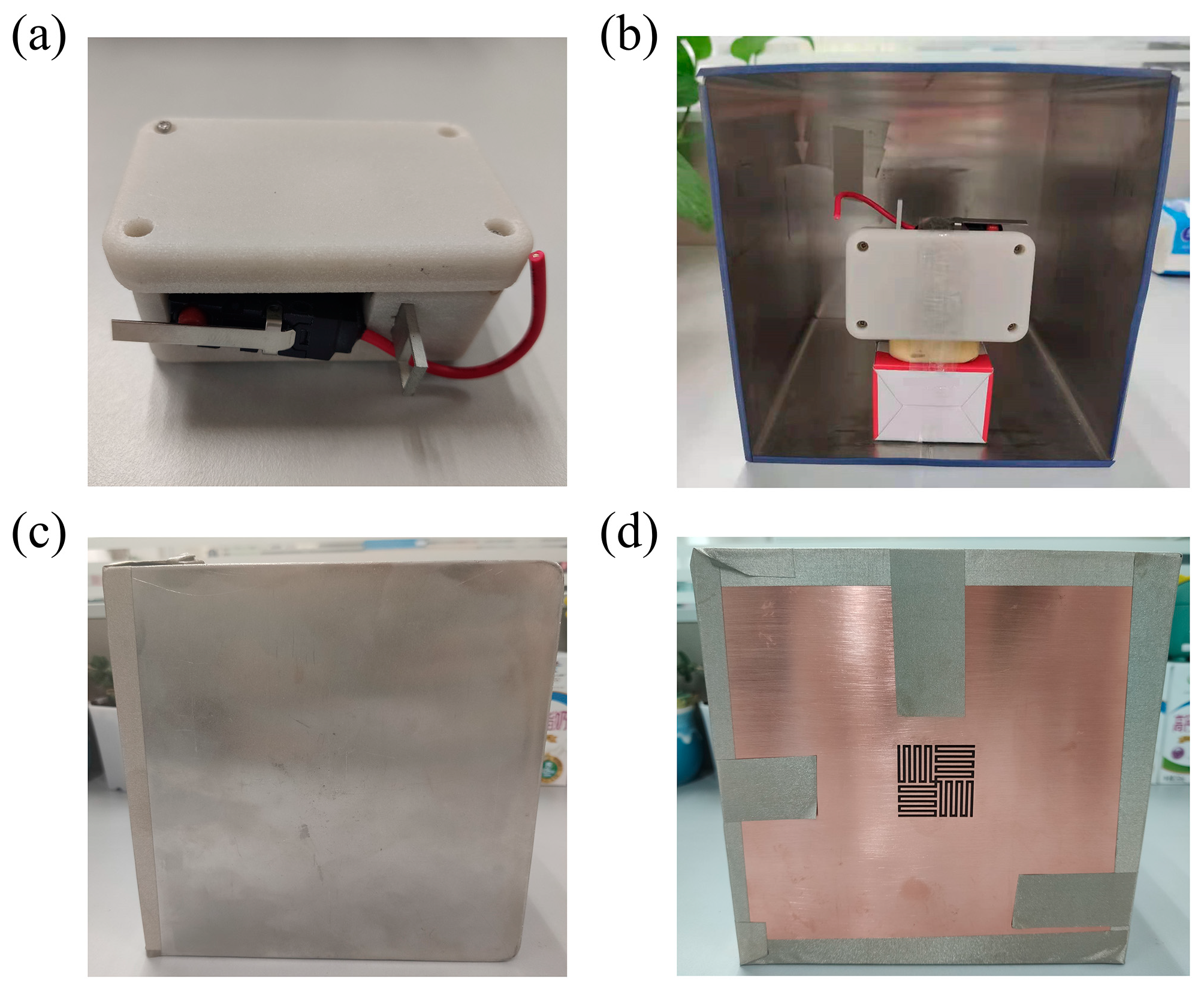Dual-Functional Cross-Meandering Resonator for Power Frequency Electromagnetic Shielding and Wireless Sensing Communication
Abstract
:1. Introduction
2. Structural Design and Analysis
3. Experiments and Results
4. Conclusions
Supplementary Materials
Author Contributions
Funding
Institutional Review Board Statement
Informed Consent Statement
Data Availability Statement
Acknowledgments
Conflicts of Interest
References
- Shi, C.; Andino-Pavlovsky, V.; Lee, S.A.; Costa, T.; Elloian, J.; Konofagou, E.E.; Shepard, K.L. Application of a sub–0.1-mm3 implantable mote for in vivo real-time wireless temperature sensing. Sci. Adv. 2021, 7, eabf6312. [Google Scholar] [CrossRef] [PubMed]
- Modalavalasa, S.; Sahoo, U.K.; Sahoo, A.K.; Baraha, S. A review of robust distributed estimation strategies over wireless sensor networks. Signal Process. 2021, 188, 108150. [Google Scholar] [CrossRef]
- Kruželák, J.; Kvasničáková, A.; Hložeková, K.; Hudec, I. Progress in polymers and polymer composites used as efficient materials for EMI shielding. Nanoscale Adv. 2021, 3, 123–172. [Google Scholar] [CrossRef]
- Zakaria, N.A.; Sudirman, R.; Jamaluddin, M.N. Electromagnetic interference effect from power line noise in electrocardiograph signal using faraday cage. In Proceedings of the 2008 IEEE 2nd International Power and Energy Conference, Johor Bahru, Malaysia, 1–3 December 2008; pp. 666–671. [Google Scholar]
- Liu, P.; Wang, P.; Deng, Y.; Wu, F.; Dai, X.; Wang, Y. Preparation of silver-coated copper electromagnetic shielding coating and its application in power frequency electromagnetic field. In Proceedings of the IOP Conference Series: Earth and Environmental Science, Bogor, Indonesia, 29 August 2019; p. 22068. [Google Scholar]
- Li, T.-W.; Li, D.; Li, E.-P. A novel FSS structure with high selectivity and excellent angular stability for 5G communication radome. In Proceedings of the 2017 10th Global Symposium on Millimeter-Waves, Hong Kong, China, 24–26 May 2017; pp. 50–52. [Google Scholar]
- Chakraborty, U.; Chatterjee, S.; Chowdhury, S.K.; Sarkar, P.P. A comact microstrip patch antenna for wireless communication. Prog. Electromagn. Res. C 2011, 18, 211–220. [Google Scholar] [CrossRef]
- Wang, H.; Qu, S.; Wang, J.; Yan, M.; Zheng, L. Dual-band miniaturised FSS with stable resonance frequencies of 3.4/4.9 GHz for 5G communication systems applications. IET Microw. Antennas Propag. 2020, 14, 1–6. [Google Scholar] [CrossRef]
- Smith, T.; Gothelf, U.; Kim, O.S.; Breinbjerg, O. An FSS-backed 20/30 GHz circularly polarized reflectarray for a shared aperture L-and Ka-band satellite communication antenna. IEEE Trans. Antennas Propag. 2013, 62, 661–668. [Google Scholar] [CrossRef]
- Ma, Y.; Wu, W.; Yuan, Y.; Zhang, X.; Yuan, N. A Wideband FSS Based on Vias for Communication Systems. IEEE Antennas Wirel. Propag. Lett. 2018, 17, 2517–2520. [Google Scholar] [CrossRef]
- Mantash, M.; Kesavan, A.; Denidni, T.A. Beam-tilting endfire antenna using a single-layer FSS for 5G communication networks. IEEE Antennas Wirel. Propag. Lett. 2017, 17, 29–33. [Google Scholar] [CrossRef]
- Hong, T.; Wang, M.; Peng, K.; Zhao, Q.; Gong, S. Compact Ultra-Wide Band Frequency Selective Surface with High Selectivity. IEEE Trans. Antennas Propag. 2020, 68, 5724–5729. [Google Scholar] [CrossRef]
- Bindu, K.; Chopra, R.; Kumar, G. Low Cost broadband stacked circular microstrip antenna. In Proceedings of the 2017 IEEE International Conference on Antenna Innovations & Modern Technologies for Ground, Aircraft and Satellite Applications (iAIM), Bangalore, India, 24–26 November 2017; pp. 1–5. [Google Scholar]
- Boukarkar, A.; Lin, X.Q.; Jiang, Y.; Yang, X.F. A Compact Frequency-Reconfigurable 36-States Patch Antenna for Wireless Applications. IEEE Antennas Wirel. Propag. Lett. 2018, 17, 1349–1353. [Google Scholar] [CrossRef]
- Zidan, M.S. Design and Analysis of Frequency-Reconfigurable Microstrip Antenna using Multiple Parasitic Patches. IOP Conf. Ser. Mater. Sci. Eng. 2019, 518, 042024. [Google Scholar] [CrossRef]
- Serup, D.E.; Williams, R.J.; Zhang, S.; Pedersen, G.F. Shared aperture dual S-and X-band antenna for nano-satellite applications. In Proceedings of the 2020 14th European conference on antennas and propagation (EuCAP), Copenhagen, Denmark, 15–20 March 2020; pp. 1–4. [Google Scholar]
- Johnson, A.D.; Manohar, V.; Venkatakrishnan, S.B.; Volakis, J.L. Low-Cost S-Band Reconfigurable Monopole/Patch Antenna for CubeSats. IEEE Open J. Antennas Propag. 2020, 1, 598–603. [Google Scholar] [CrossRef]
- Sun, M.; Zhang, Z.; Zhang, F.; Chen, A. L/S Multiband Frequency-Reconfigurable Antenna for Satellite Applications. IEEE Antennas Wirel. Propag. Lett. 2019, 18, 2617–2621. [Google Scholar] [CrossRef]
- Akhila, P.; Kumar, S.A.; Shanmuganantham, T. Antenna design for nanosatellite payload communication system. In Proceedings of the 2020 IEEE International Conference on Electronics, Computing and Communication Technologies (CONECCT), Bangalore, India, 2–4 July 2020; pp. 1–3. [Google Scholar]
- Ramahatla, K.; Mosalaosi, M.; Yahya, A.; Basutli, B. Multiband Reconfigurable Antennas for 5G Wireless and CubeSat Applications: A Review. IEEE Access 2022, 10, 40910–40931. [Google Scholar] [CrossRef]
- Koroglu, S.; Umurkan, N.; Kilic, O. Experimental performance investigation of double-layer shields at power frequency magnetic shielding. In Proceedings of the 2008 Power Quality and Supply Reliability Conference, Parnu, Estonia, 27–29 August 2008; pp. 207–210. [Google Scholar]
- Geetha, S.; Satheesh Kumar, K.K.; Rao, C.R.K.; Vijayan, M.; Trivedi, D.C. EMI shielding: Methods and materials-A review. J. Appl. Polym. Sci. 2009, 112, 2073–2086. [Google Scholar] [CrossRef]
- Xiao, D.; Liu, Y.; Li, S.; Sun, O. An Improved Design of Center-Fed SIW Slot Dual-Layered Substrate Antenna. In Proceedings of the 2022 International Conference on Microwave and Millimeter Wave Technology (ICMMT), Harbin, China, 12–15 August 2022; pp. 01–03. [Google Scholar]
- Foudazi, A.; Hassani, H.R.; Nezhad, S.M.A. Small UWB Planar Monopole Antenna with Added GPS/GSM/WLAN Bands. IEEE Trans. Antennas Propag. 2012, 60, 2987–2992. [Google Scholar] [CrossRef]
- Wu, M.-T.; Chuang, M.-L. Multibroadband Slotted Bow-Tie Monopole Antenna. IEEE Antennas Wirel. Propag. Lett. 2015, 14, 887–890. [Google Scholar] [CrossRef]
- Sivasamy, R.; Moorthy, B.; Kanagasabai, M.; Samsingh, V.R.; Alsath, M.G.N. A wideband frequency tunable FSS for electromagnetic shielding applications. IEEE Trans. Electromagn. Compat. 2017, 60, 280–283. [Google Scholar] [CrossRef]
- Gurrala, P.; Oren, S.; Liu, P.; Song, J.; Dong, L. Fully conformal square-patch frequency-selective surface toward wearable electromagnetic shielding. IEEE Antennas Wirel. Propag. Lett. 2017, 16, 2602–2605. [Google Scholar] [CrossRef]
- Syed, I.S.; Ranga, Y.; Matekovits, L.; Esselle, K.P.; Hay, S.G. A single-layer frequency-selective surface for ultrawideband electromagnetic shielding. IEEE Trans. Electromagn. Compat. 2014, 56, 1404–1411. [Google Scholar] [CrossRef]
- Li, M.; Zhong, B.G.; Cheung, S.W. Isolation Enhancement for MIMO Patch Antennas Using Near-Field Resonators as Coupling-Mode Transducers. IEEE Trans. Antennas Propag. 2019, 67, 755–764. [Google Scholar] [CrossRef]
- Li, K.; Hogan, N.J.; Kale, M.J.; Halas, N.J.; Nordlander, P.; Christopher, P. Balancing Near-Field Enhancement, Absorption, and Scattering for Effective Antenna–Reactor Plasmonic Photocatalysis. Nano Lett. 2017, 17, 3710–3717. [Google Scholar] [CrossRef]
- Zhang, M.; Zhang, F.; Ou, Y.; Cai, J.; Yu, H. Broadband terahertz absorber based on dispersion-engineered catenary coupling in dual metasurface. Nanophotonics 2019, 8, 117–125. [Google Scholar] [CrossRef]
- Varkani, A.R.; Firouzeh, Z.H.; Nezhad, A.Z. Equivalent circuit model for array of circular loop FSS structures at oblique angles of incidence. Iet Microw. Antennas Propag. 2018, 12, 749–755. [Google Scholar] [CrossRef]
- Mahdi, R.; Hamid, R.; Ali, A. Multilayer graphene-based metasurfaces: Robust design method for extremely broadband, wide-angle, and polarization-insensitive terahertz absorbers. Appl. Opt. 2018, 57, 959. [Google Scholar]
- Barzegar-Parizi, S. Realization of wide-angle and wideband absorber using metallic and graphene-based metasurface for mid-infrared and low THz frequency. Opt. Quantum Electron. 2018, 50, 378. [Google Scholar] [CrossRef]
- Yan, M.; Qu, S.; Wang, J.; Ma, H.; Zhang, J.; Wang, W.; Zheng, L.; Yuan, H. A single layer ultra-miniaturized FSS operating in VHF. Photonics Nanostructures Fundam. Appl. 2015, 17, 1–9. [Google Scholar] [CrossRef]
- Sheokand, H.; Ghosh, S.; Singh, G.; Saikia, M.; Srivastava, K.V.; Ramkumar, J.; Anantha Ramakrishna, S. Transparent broadband metamaterial absorber based on resistive films. J. Appl. Phys. 2017, 122, 105105. [Google Scholar] [CrossRef]







| 1 | 2 | 3 | 4 | 5 | |
|---|---|---|---|---|---|
| Open | 0.446 | 0.442 | 0.452 | 0.450 | 0.448 |
| Permalloy lid | <0.01 | <0.01 | <0.01 | <0.01 | <0.01 |
| Resonator sample | <0.01 | <0.01 | <0.01 | <0.01 | <0.01 |
| 1 | 2 | 3 | 4 | 5 | 6 | 7 | 8 | 9 | 10 | 11 | 12 | 13 | 14 | 15 | Probability | |
|---|---|---|---|---|---|---|---|---|---|---|---|---|---|---|---|---|
| Open | √ | √ | √ | √ | √ | √ | √ | √ | √ | √ | √ | √ | √ | √ | √ | 93% |
| √ | √ | × | √ | √ | √ | × | √ | √ | √ | √ | √ | √ | √ | √ | ||
| Permalloy lid | × | × | × | × | × | × | × | × | × | × | × | × | × | × | × | 0% |
| Resonator sample | √ | × | × | × | √ | √ | × | √ | × | √ | × | √ | √ | √ | × | 53% |
| 1 | 2 | 3 | 4 | 5 | 6 | 7 | 8 | 9 | 10 | 11 | 12 | 13 | 14 | 15 | Probability | |
|---|---|---|---|---|---|---|---|---|---|---|---|---|---|---|---|---|
| Open | √ | √ | √ | √ | √ | √ | √ | √ | √ | √ | √ | √ | √ | √ | √ | 100% |
| √ | √ | √ | √ | √ | √ | √ | √ | √ | √ | √ | √ | √ | √ | √ | ||
| Resonator sample | √ | √ | √ | √ | √ | √ | √ | √ | √ | √ | √ | √ | √ | √ | √ | 100% |
Disclaimer/Publisher’s Note: The statements, opinions and data contained in all publications are solely those of the individual author(s) and contributor(s) and not of MDPI and/or the editor(s). MDPI and/or the editor(s) disclaim responsibility for any injury to people or property resulting from any ideas, methods, instructions or products referred to in the content. |
© 2024 by the authors. Licensee MDPI, Basel, Switzerland. This article is an open access article distributed under the terms and conditions of the Creative Commons Attribution (CC BY) license (https://creativecommons.org/licenses/by/4.0/).
Share and Cite
Gan, F.; Shang, X.; Yang, X.; Li, S.; Zhou, Y.; Li, W. Dual-Functional Cross-Meandering Resonator for Power Frequency Electromagnetic Shielding and Wireless Sensing Communication. Sensors 2024, 24, 5615. https://doi.org/10.3390/s24175615
Gan F, Shang X, Yang X, Li S, Zhou Y, Li W. Dual-Functional Cross-Meandering Resonator for Power Frequency Electromagnetic Shielding and Wireless Sensing Communication. Sensors. 2024; 24(17):5615. https://doi.org/10.3390/s24175615
Chicago/Turabian StyleGan, Fengyuan, Xiangshuo Shang, Xuelei Yang, Shuo Li, Yi Zhou, and Wei Li. 2024. "Dual-Functional Cross-Meandering Resonator for Power Frequency Electromagnetic Shielding and Wireless Sensing Communication" Sensors 24, no. 17: 5615. https://doi.org/10.3390/s24175615







